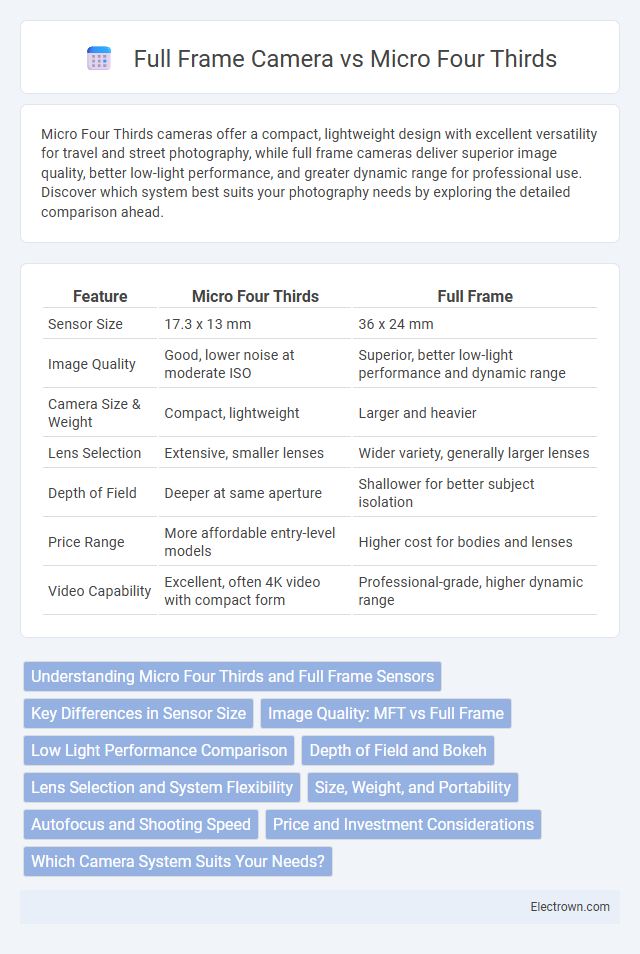Micro Four Thirds cameras offer a compact, lightweight design with excellent versatility for travel and street photography, while full frame cameras deliver superior image quality, better low-light performance, and greater dynamic range for professional use. Discover which system best suits your photography needs by exploring the detailed comparison ahead.
Table of Comparison
| Feature | Micro Four Thirds | Full Frame |
|---|---|---|
| Sensor Size | 17.3 x 13 mm | 36 x 24 mm |
| Image Quality | Good, lower noise at moderate ISO | Superior, better low-light performance and dynamic range |
| Camera Size & Weight | Compact, lightweight | Larger and heavier |
| Lens Selection | Extensive, smaller lenses | Wider variety, generally larger lenses |
| Depth of Field | Deeper at same aperture | Shallower for better subject isolation |
| Price Range | More affordable entry-level models | Higher cost for bodies and lenses |
| Video Capability | Excellent, often 4K video with compact form | Professional-grade, higher dynamic range |
Understanding Micro Four Thirds and Full Frame Sensors
Micro Four Thirds sensors measure approximately 17.3 x 13 mm, offering a crop factor of 2x that affects field of view and depth of field, making lenses appear more zoomed-in compared to full frame sensors. Full frame sensors, typically 36 x 24 mm, provide superior image quality, better low-light performance, and wider dynamic range due to their larger surface area for light capture. Understanding these sensor differences helps you choose the right camera system based on your photography needs and shooting conditions.
Key Differences in Sensor Size
Micro Four Thirds cameras feature a sensor size of approximately 17.3 x 13 mm, significantly smaller than Full Frame sensors, which measure 36 x 24 mm. This difference in sensor size results in varying image quality, low-light performance, and depth of field capabilities, with Full Frame sensors generally offering superior dynamic range and noise control. Additionally, lens design and field of view differ substantially, as Micro Four Thirds cameras multiply focal length by a 2x crop factor compared to Full Frame.
Image Quality: MFT vs Full Frame
Full Frame cameras generally deliver superior image quality due to larger sensors that capture more light, resulting in better low-light performance and greater dynamic range. Micro Four Thirds (MFT) sensors, being smaller, often produce images with more noise at higher ISO settings and less depth of field control. Your choice depends on whether you prioritize portability and versatility from MFT or the enhanced image fidelity and detail of Full Frame systems.
Low Light Performance Comparison
Full Frame cameras generally outperform Micro Four Thirds in low light conditions due to their larger sensor size, which captures more light and reduces noise at higher ISO settings. Micro Four Thirds sensors, being smaller, often struggle with noise and detail retention when shooting in dim environments. If your priority is superior low light performance, a Full Frame camera will likely deliver clearer, cleaner images with better dynamic range.
Depth of Field and Bokeh
Micro Four Thirds cameras feature a smaller sensor size compared to Full Frame cameras, resulting in a deeper depth of field that keeps more of the scene in focus. Full Frame cameras excel at creating a shallower depth of field, allowing for more pronounced bokeh effects with smoother, creamier background blur. Your choice between the two influences the creative control over subject isolation and artistic background aesthetics in photography.
Lens Selection and System Flexibility
Micro Four Thirds cameras offer a wide range of compact, lightweight lenses ideal for travel and everyday photography, with extensive third-party options increasing system flexibility. Full Frame cameras provide superior image quality with larger sensors and typically feature high-end, professional-grade lenses that excel in low-light and portrait photography. Both systems support versatile lens mounts, but Micro Four Thirds prioritize portability while Full Frame emphasizes optical performance and depth of field control.
Size, Weight, and Portability
Micro Four Thirds cameras offer a compact form factor with smaller sensors measuring 17.3 x 13 mm, resulting in significantly reduced size and weight compared to full frame cameras, which feature larger 36 x 24 mm sensors. This sensor size difference allows Micro Four Thirds systems and lenses to be more portable, ideal for travel and street photography where lightweight gear enhances mobility. Full frame cameras typically provide superior image quality and low-light performance but at the cost of increased bulk and heavier equipment, making Micro Four Thirds a preferred option for photographers prioritizing convenience and ease of carrying.
Autofocus and Shooting Speed
Micro Four Thirds cameras often feature advanced contrast-detection and phase-detection autofocus systems, delivering fast and accurate focus ideal for action and wildlife photography. Full Frame cameras typically provide larger autofocus sensors and more focus points, enhancing low-light performance and subject tracking for professional-grade shooting speed. Both systems offer high burst rates, but Full Frame models usually excel with faster continuous shooting speeds, benefiting sports and fast-moving subjects.
Price and Investment Considerations
Micro Four Thirds cameras generally come at a lower price point compared to full frame cameras, making them a more budget-friendly option for photographers starting out or those looking to minimize upfront investment. Full frame cameras, while more expensive, offer higher image quality and advanced features that can justify the cost for professional use or long-term investment. Your choice should balance initial affordability with potential future returns in terms of image performance and system versatility.
Which Camera System Suits Your Needs?
Micro Four Thirds cameras offer compact size, lighter weight, and greater lens versatility, ideal for travel and street photography where portability is key. Full Frame cameras provide superior image quality, better low-light performance, and wider dynamic range, making them perfect for professional work and high-resolution photography. Assess your shooting style and requirements to determine which system best aligns with your creative goals and practical needs.
Micro Four Thirds vs Full Frame Camera Infographic

 electrown.com
electrown.com